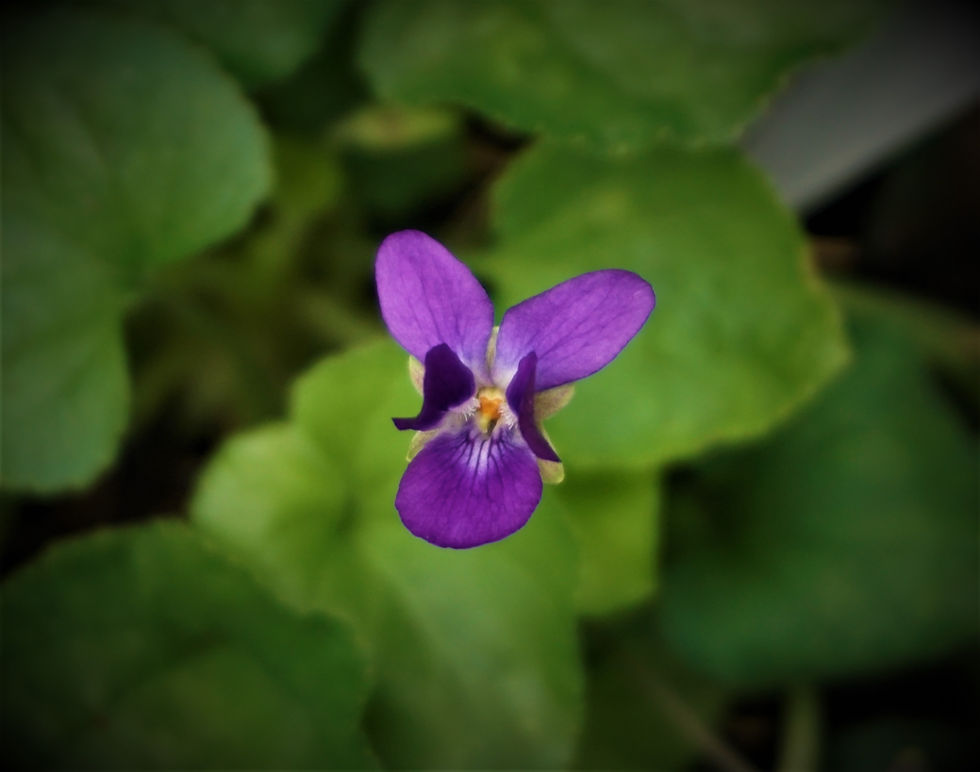Violet Syrup: Sirop Violat
- Rebecca Drew

- Mar 1, 2022
- 3 min read
Spring brings so much beauty to the southern United States. Some of the beauty comes in the form of sweet violets sprinkled amongst the newly emerging greenery, even in March!

La Violette does not need any translation. Although I cannot bring myself to eat them, you may find crystallized blooms on lovely floral cakes. This year in 2022, Mardi Gras falls on March 1st, but I'm not sure if any violets will be found that soon. Nonetheless, there is a recipe for Candied Violets in the classic Louisiana cookbook, Talk about Good!, known for its vast repertoire of Acadian cuisine. If you have the original cookbook, the recipe is on page 420, contributed by Mrs. William E. Wallace. I would love to include it here, but I don't know if there's a copyright issue, so just know that it only requires three ingredients: violets, egg whites, and confectioners' sugar.
Earlier antique cookbooks point to other culinary uses for violets, too. There is a recipe for Violet Syrup (Sirop Violat) in La Cuisinière Bourgeoise, the cookbook written in France and provided to people in Québec in the early 1800's. Notice how the word for violet is spelled"violat" rather than "violette" or "violet" in this recipe. Let's clarify a few things before translating it. First, the color violet is spelled the same in French and English. However, the flower is spelled "violette" in French while retaining the spelling of "violet" in English. The French variation of "violat" refers to an extraction of the violet/violette plant, which is the case for this recipe. Also, you may run across the word "violâtre" which is an adjective synonymous with purplish or mauvish. Now, let's go back to our recipe:
Sirop Violat
Sur un quarteron de violettes épluchées que vous mettez dans une terrine, versez dessus un demi-setier d'eau bouillante; mettez quelque chose de propre sur les violettes pour les tenir enfoncées dans l'eau, couvrez-les et les mettez sur de la cendre chaude pendant deux heurs; ensuite vous passez les violettes au travers d'un linge, que vous pressez fort pour faire sortir l'eau; cette quantité de violettes doit vous rendre près d'une pinte; si vous l'avez, vous mettrez deux livres et demie de sucre dans une poile, avec un demi-setier* d'eau, faites-le bouillir et écumer, continnez de le faire bouillir jusqu'à ce que, trempant les doigts dans l'eau et les mettant dans le sucre (vous les retrempez dans l'eau), le sucre que tient à vos doigts se casse net; alors, vous y versez votre eau de violettes: ayez soin que votre sirop ne bouille pas; quand ils seront bien incorporés ensemble, mettez le sirop dans une terrine, couvrez-la et la mettez sur une cendre chaude pendant trois jours; entrenez la chaleur la plus égale que vous pourrez, sans qu'elle soit trop forte; vous connaîtrez que le sirop sera fait en mettant deux doigts dedans et les retirant écartés; s'il se forme un fil qui ne se rompt pas, vous le mettrez dans les bouteilles.
Violet Syrup
On a quarter pound of peeled violets that you put in a terrine, pour over two quarts* of boiling water; put something clean on the violets to hold them in the water, cover them and put them on hot ashes for two hours; then you pass the violets through a cloth, which you press hard to get the water out; this amount of violets should give you a pint; if you have it, you will put two and a half pounds of sugar in a pan, with two quarts of water; boil and skim it, keep it boiling until the point when dipping your fingers in the water and putting them in the sugar (you re-dip them in the water), causes the sugar in your fingers to break its net; then, you pour your water of violets into it: take care that your syrup does not boil; when they are well incorporated together, put the syrup in a terrine, cover it and put it on hot ashes for three days; give it the most even heat you can, without being too strong; you will know the syrup has been made by putting in two fingers and pulling them apart; if a thread forms which does not break, you can put it in the bottles.
*A setier was an archaic term for 4 quarts, but the measure could vary by location within France. In this case, a demi-setier would equal about half of 4 quarts, hence the 2 quarts shown here.
Perhaps you could use this recipe as part of a Mardi Gras celebration, such as pouring the syrup on a purple and green King Cake. Yum! Or, you could do what I plan on doing, which is letting the violets bloom in the sun while simply using this recipe to practice French!



